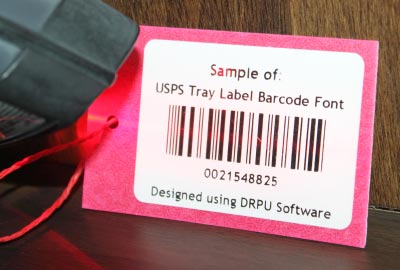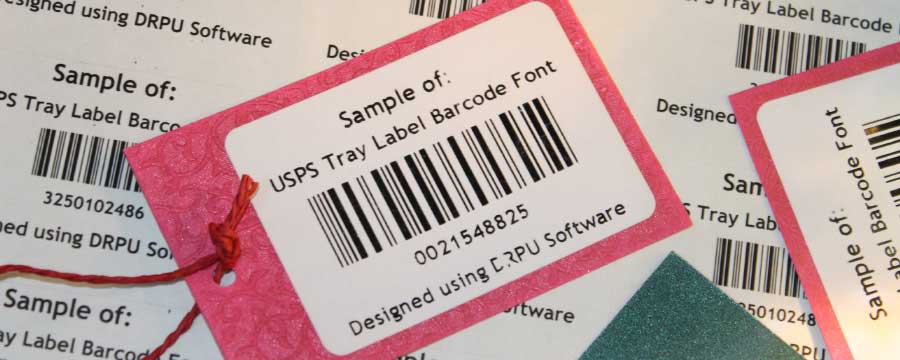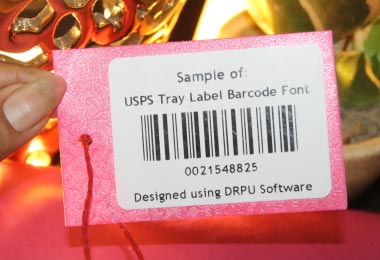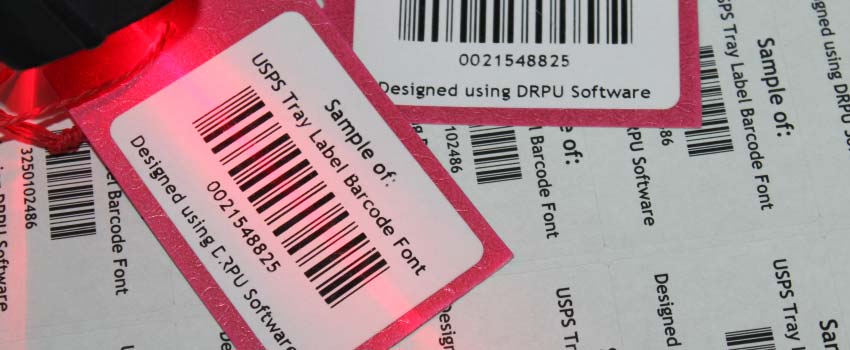Types Of Devices that can Read USPS Tray Label Barcode

USPS tray label barcodes can be read using a variety of devices, including barcode scanners, mobile devices, and computer systems. The key requirement for any device used to read USPS tray label barcodes is compatibility with the barcode symbology used by the USPS.
❖ USPS tray label barcodes are typically printed in Code 128 symbology, which is a high-density, variable-length, linear barcode symbology. Code 128 barcodes can be read by a wide range of devices, including handheld laser scanners, CCD scanners, mobile device cameras, and computer systems with appropriate barcode scanning software.
❖ Handheld laser scanners are the most commonly used devices for reading USPS tray label barcodes. These scanners use a laser beam to read the barcode, which is reflected back to the scanner and converted into a digital signal. Laser scanners are highly accurate and can read barcodes from a distance of several inches.
❖ CCD scanners are another type of handheld barcode scanner that can be used to read USPS tray label barcodes. CCD scanners use an array of light sensors to capture an image of the barcode, which is then decoded into digital data. CCD scanners are typically less expensive than laser scanners but may have lower accuracy and require closer proximity to the barcode.
❖ Mobile devices such as smartphones and tablets can also be used to read USPS tray label barcodes. These devices use the built-in camera to capture an image of the barcode, which is then decoded using a barcode scanning app. Barcode scanning apps are available for both Android and iOS devices and can be downloaded from app stores.
❖ Computer systems with appropriate barcode scanning software can also be used to read USPS tray label barcodes. This may include desktop computers, laptops, or specialized scanning systems. Barcode scanning software is available from a variety of vendors and can be integrated with existing systems to automate the scanning and tracking of USPS trays.
In summary, a wide range of devices can be used to read USPS tray label barcodes, including handheld laser scanners, CCD scanners, mobile devices, and computer systems with appropriate barcode scanning software. Compatibility with Code 128 symbology is the key requirement for any device used to read USPS tray label barcodes. By using the appropriate devices to read tray label barcodes, the USPS can improve the accuracy and efficiency of mail processing and tracking.
USPS Tray Label Barcode be used Internationally
The USPS tray label barcode is a unique barcode symbology used by the United States Postal Service (USPS) to automate and streamline the processing and tracking of mail and packages within the United States. As such, the tray label barcode is designed specifically for use within the USPS network and is not intended for use in international mail processing.
However, in order for the USPS tray label barcode to be recognized and processed by international postal systems, it must be accompanied by other barcode symbologies and postal markings that are recognized internationally. These may include UPU-compliant barcodes, address labels, and customs declarations.

International mail processing typically involves the use of different barcode symbologies, depending on the country or region of origin and destination. For example, the Universal Postal Union (UPU) has established a set of barcode symbologies and specifications that are widely used in international mail processing. These include the UPU S10, S23, and S42 symbologies, which are used for encoding postal information such as destination, routing, and tracking data.
While the USPS tray label barcode is not intended for use in international mail processing, it may still be included on mail pieces that are sent internationally. This is because the tray label barcode is often used to identify and track mail trays as they move through the USPS network, and may be included on the labels affixed to individual mail pieces contained within the tray.
In summary, the USPS tray label barcode is not designed for use in international mail processing and is intended only for use within the USPS network. While it may be included on mail pieces sent internationally, it must be accompanied by other barcode symbologies and postal markings in order to be recognized and processed by international postal systems.
Download and Install
Barcode Label Maker SoftwareUses Of USPS Tray Label Barcode

The USPS tray label barcode is a powerful tool that the United States Postal Service (USPS) uses to track and sort mail trays as they move through the postal system. Despite its many advantages, using tray label barcodes that can impact their effectiveness in certain situations.
generating a USPS tray label barcode requires obtaining the tray label information, choosing a barcode generator, inputting the information, verifying and testing the barcode, printing the label, and affixing it to the tray according to USPS guidelines.
Limitations Using USPS Tray Label Barcode
Some of the limitations of USPS tray label barcodes are:
-
01Dependence
on Technology
The use of tray label barcodes is highly dependent on technology. If the barcode scanners or other equipment used to read the barcodes fail, or if there are technical issues with the barcode system, mail trays may not be tracked or sorted accurately. This can result in delays or errors in mail delivery. Additionally, in the event of a power outage or other disruption to the USPS network, the tray label barcode system may be temporarily unavailable, further disrupting mail processing operations.
-
02Limited
Compatibility with Legacy Systems
Another limitation of tray label barcodes is that they may not be compatible with legacy mail processing systems that do not have the capability to read or process barcode data. While the USPS has made significant investments in modernizing its mail processing equipment, there may still be some older systems in use that cannot handle tray label barcodes. This can limit the effectiveness of the barcode system in some instances.
-
03Complexity
of Implementation
Implementing a tray label barcode system can be complex and time-consuming. In order to use the barcode system effectively, the USPS must develop and deploy specialized software and hardware that can read and process barcode data. This requires significant investments in infrastructure, personnel, and training. Additionally, the barcode system must be integrated with other USPS systems and processes to ensure that mail trays are accurately tracked and sorted throughout the postal system.
-
04Limited
Data Capacity
The tray label barcode is a 4-state barcode, which means that it can encode up to 31 characters of data. While this is generally sufficient to encode the necessary information about the contents of a mail tray, there may be instances where additional data must be recorded, such as when handling bulky or oversized mail items. In these instances, additional tracking or identification methods may be necessary to supplement the tray label barcode.
-
05Limited
International Use
The tray label barcode is primarily used within the United States postal system, and may not be recognized or compatible with postal systems in other countries. This can limit its usefulness for international mail processing and tracking.
-
06Environmental Limitations
The tray label barcode is printed on a paper label that is affixed to the mail tray. This label can become damaged or illegible if exposed to moisture, extreme temperatures, or other environmental factors. In instances where mail trays are transported over long distances or through harsh environmental conditions, the label may need to be reinforced or protected to ensure that it remains legible and scannable.
Overall, while the tray label barcode is a powerful tool for the USPS, it is not without its limitations. These limitations can impact the effectiveness of the barcode system in certain situations and must be taken into consideration when designing and implementing mail processing and tracking systems.
Cost Of Implementing USPS Tray Label Barcode
-
The cost of implementing USPS tray label barcode depends on a variety of factors, including the volume of mail being processed, the types of equipment and software used, and the level of automation desired. In general, however, implementing USPS tray label barcode can provide significant cost savings and efficiency improvements for mail processing operations. The cost of implementing USPS tray label barcode can vary depending on the type of equipment.
-
One of the primary advantages of using USPS tray label barcode is its ability to automate and streamline the sorting and tracking of mail trays. By encoding key information such as destination, routing, and tray identification into a barcode, USPS tray label barcode allows mail processing equipment to read and sort trays automatically, without the need for manual intervention. This can reduce labor costs and improve processing times, especially for large volumes of mail.
-
In addition to labor savings, implementing USPS tray label barcode can also reduce the likelihood of errors and misrouted mail. The barcode system provides a standardized method for identifying and tracking mail trays, which helps to ensure that each tray is processed correctly and efficiently. This can help to reduce the need for manual intervention, which can be time-consuming and error-prone. Maintaining and upgrading USPS tray label barcode systems.
For example, some mail processing systems may require specialized hardware or software to read and process tray labels, which can be costly to implement. Other systems may be able to use existing equipment and software, which can help to reduce the cost of implementation.. This may include the cost of replacing worn or damaged equipment, upgrading software, and training staff on new procedures and technologies. However, these costs are generally outweighed by the long-term benefits of increased efficiency and accuracy in mail processing operations.

Overall, implementing USPS tray label barcode can provide significant cost savings and efficiency improvements for mail processing operations. While there may be some initial costs associated with implementing the system, these costs are generally offset by the long-term benefits of increased efficiency and accuracy. For this reason, USPS tray label barcode is widely used by mail processing operations of all sizes, from small businesses to large corporations and government agencies.
Generate USPS Tray Label Barcodes System
Generating a USPS tray label barcode is a relatively simple process that involves using specialized software or online tools that can create and format the barcode according to USPS requirements. Here are the steps to generate a USPS tray label barcode:
The first step in generating a USPS tray label barcode is to obtain the tray label information. This information typically includes the USPS facility ID, the tray type, and the tray number.
Once you have the tray label information, you can choose a barcode generator that is compatible with the USPS tray label barcode format. There are several software programs and online tools available that can generate USPS tray label barcodes, such as Barcode Generator or BarTender.
Using the chosen barcode generator, input the tray label information into the software. The software will then generate a barcode that is formatted according to USPS specifications. Ensure that the barcode size and placement are correct for your label format.
After generating the barcode, it is important to verify and test its accuracy and readability. This can be done by using a barcode scanner or testing the barcode with USPS-approved equipment. Any errors or issues with the barcode should be corrected before printing the tray label.
Once the barcode has been verified and tested, it can be printed on the tray label. Ensure that the printer settings are set to the appropriate size and resolution, and that the label stock is compatible with the printer.
After printing, affix the tray label to the tray according to USPS guidelines, ensuring that the barcode is placed in the correct location and is not obscured by any other labels or markings.
Download and Install
Barcode Label Maker Software DOWNLOAD
DOWNLOAD DOWNLOAD
DOWNLOAD